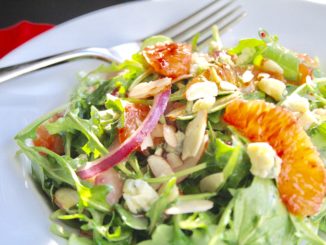
A roux is a thickener, equal amounts (give or take) of fat and flour whisked and cooked together to produce a powerful paste full of starch that will give your sauces, soups, stews and gravies just the right consistency. If you’ve ever made a bechamel sauce, gravy or gumbo, you’ve likely made a roux.
How to Make a Roux
Most roux are made by whisking flour into melted butter over low heat, but you can also use the fat rendered by frying bacon (remove the bacon from the pan before adding the flour) or oil in place of the butter. Once the flour’s added it’s time for some serious whisking to make sure the fat and flour combine well, but also to keep it moving in the pan. Both flour and butter burn quickly and easily and a vigorous whisking allows them to cook gradually without burning (burnt flour taste = yuck). It’s important to let the mixture cook for at least a minute or so to cook the flour so your dish won’t taste like, well, uncooked flour.
There are three distinct stages or types of roux. White is what you should have after whisking the flour and butter together for three to five minutes. It should be thick, white in color and should be pretty tasteless in your finished dish. Cook it 3-5 minutes more — keep whisking — and you’ll have a blond roux, a slightly thinner mixture with a yellow tinge. Three to five minutes more and you’ll have a brown roux, a thin, brown mix that will give foods a nutty flavor.
What’s the difference, besides the color, consistency and taste? Well, the longer you cook it, the less thickening power it’s going to have. White roux are usually added to sauces and such that you want to be extra thick or creamy while brown roux are most often used to stews or gumbos.
Did someone mention gumbo? Because I have a terrific recipe for Shrimp & Andouille Sausage Gumbo, that’s made with — you guessed it — a roux. Get this on your Mardi Gras table immediately!
TIPS:
Whisk CONSTANTLY once you add the flour. You have to keep it moving to prevent it from burning.
If you burn your roux (it happens, don’t sweat it), start over. If you power thru your gumbo will taste only of burnt flour.
TOOLS:
Large Pot
TECHNIQUES:
Sweating Vegetables
The tools section may contain affiliate links to products we know and love.
Ingredients
- 4 tablespoons olive oil, divided
- 12 ounces andouille sausage, sliced 1/2-inch thick
- 1 medium onion, diced
- 1 medium green bell pepper, diced
- 1 medium red bell pepper, diced
- 2 stalks celery, chopped (about 1/2 cup)
- 4 cloves garlic, minced
- 1/3 cup flour
- 3/4 cup white wine
- 1 bay leaf
- 1 28-oz can diced tomatoes
- 3 cups chicken stock or broth
- 1 pound shrimp, peeled and deveined
- salt and pepper, to taste
Instructions
- Heat 2 tablespoons oil in a large pot over medium high heat. Add sausage and cook until brown and crisp, about 5 minutes. Use a slotted spoon to remove sausage from pan and set aside.
- Add remaining 2 tablespoons oil to pan and add onion, peppers, celery and garlic. Cook, stirring occasionally, until the vegetables begin to soften and brown slightly, 2-3 minutes.
- Whisk in flour and continue cooking, whisking constantly, until roux thickens and flour begins to brown, about 6-8 minutes.
- Whisk in the wine, then add the bay leaf, tomatoes and chicken stock. Return the sausage to the pan and bring the gumbo to a boil. Reduce heat and simmer the gumbo for 15-20 minutes. Add shrimp and simmer for an additional 3-5 minutes until shrimp are cooked through.
- Serve gumbo with cooked rice.







1 Trackback / Pingback